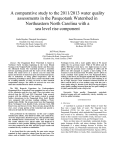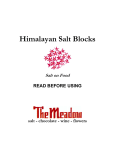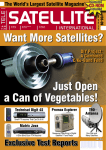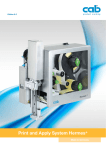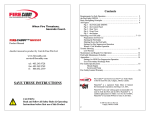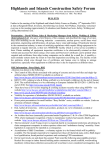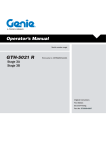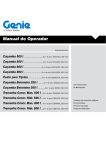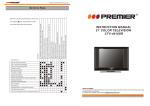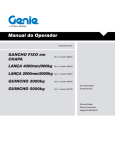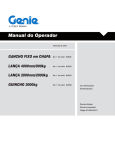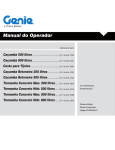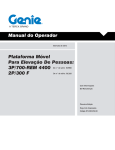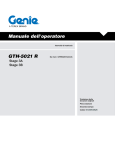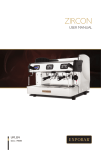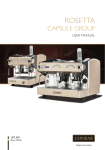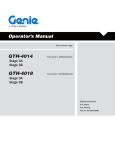Download 500L from SN SHOV50014B-1001 (PN 57.0303
Transcript
Operator’s Manual Serial number range 500L Loading Shovel.......from serial n: SHOV50014B-1001 800L Loading Shovel.......from serial n: SHOV80014B-1001 Brick-Holder Basket.........from serial n: BBSKET14B-1001 250L Mixing Bucket........from serial n: MXBC25014B-1001 500L Mixing Bucket........from serial n: MXBC50014B-1001 500L Man. Conc. Bucket....from s/n: CB500MA14B-1001 500L Hyd. Conc. Bucket.....from s/n: CB500HY14B-1001 With Maintenance Information 800L Man. Conc. Bucket....from s/n: CB800MA14B-1001 800L Hyd. Conc. Bucket.....from s/n: CB800HY14B-1001 First Edition First Printing Part No. 57.0303.5193 Operator’s Manual First Edition - First Printing Contents Introduction ..........................................Page Equipment Identification ......................Page Labels And Plates Applied...................Page Safety Precautions ..............................Page Equipment Description ..........................Page Inspections ..........................................Page Operating Instructions .........................Page Maintenance ........................................Page Load Charts .........................................Page Diagrams And Schemes ......................Page EC Declaration of Conformity ..............Page TEREX Global GmbH Copyright © 2014 by Terex Corporation Muhlenstrasse 26 8200 Schaffhausen Switzerland First Edition: First Printing, August 2014 Technical Assistance Service Telephone: +39 075 9418129 +39 075 9418175 e-mail: [email protected] 2 Genie is a registered trademark of Terex South Dakota, Inc. in the U.S.A. and many other countries. “GTH” is a trademark of Terex South Dakota, Inc. BUCKET - BASKET Part No. 57.0303.5193 3 5 7 9 17 21 25 41 45 55 57 First Edition - First Printing Operator’s Manual Introduction Symbols Safety alert symbol: used to alert you to potential personal injury hazards. Obey all safety messages that follow this symbol to avoid possible injury or death DANGER Red: indicates a hazardous situation which, if not avoided, will result in death or serious injury. WARNING Orange: indicates a hazardous situation which, if not avoided, could result in death or serious injury. CAUTION NOTICE PROTECT THE ENVIRONMENT Yellow : indicates a hazardous situation which, if not avoided, could result in minor or moderate injury. Blue: indicates a hazardous situation which, if not avoided, could result in property damage. Green: used to draw the attention to important information on environment protection. Part No. 57.0303.5193 BUCKET - BASKET 3 Operator’s Manual First Edition - First Printing Intentionally blank page 4 BUCKET - BASKET Part No. 57.0303.5193 First Edition - First Printing Operator’s Manual Equipment Identification Check that the Operator's Manual refers to the delivered equipment. DESIGNATION: LOADING SHOVEL BRICK-HOLDER BASKET MIXING BUCKET CONCRETE BUCKET APPLICABLE STANDARDS For the operator’s safety, the following standards were obeyed during the risk assessment of the handler fitted with telescopic boom norme: Directive Title 2006/42/EC Machinery Directive Standard Title EN 1459:1988/A2:2009 Safety of Industrial trucks Self- propelled variable reach trucks. MODEL: 500L Loading Shovel 800L Loading Shovel Brick-Holder Basket 250L Mixing Bucket 500L Mixing Bucket 500L Man. Concrete Bucket 500L Hyd. Concrete Bucket 800L Man. Concrete Bucket 800L Hyd. Concrete Bucket IDENTIFICATION PLATE The data plate is applied on the equipment. The identification plate contains model, designation, serial number, weight, payload and year of manufacture. PRODUCT IDENTIFICATION The attachment serial number is located on the serial label. • • • • • • • • • • • 500L Loading Shovel 59.0201.9009 GT 800L Loading Shovel 59.0201.9010 GT 800L Loading Shovel 59.0201.9013 GT 800L Loading Shovel 59.0201.9008 GT Brick-Holder Basket 59.0401.2013 GT 250L Mixing Bucket 59.0401.2018 GT 500L Mixing Bucket 59.0401.2016 GT 500L Man. Concrete Bucket 59.0401.2012 GT 500L Hyd. Concrete Bucket 59.0401.2013 GT 800L Man. Concrete Bucket 59.0401.2014 GT 800L Hyd. Concrete Bucket 59.0401.2015 GT Part No. 57.0303.5193 BUCKET - BASKET 5 Operator’s Manual First Edition - First Printing Intentionally blank page 6 BUCKET - BASKET Part No. 57.0303.5193 First Edition - First Printing Operator’s Manual Labels And Plates Applied IDENTIFICATION PLATE 50 mm 100 mm 09.4618.1354 09.4618.1355 800 Kg 09 4618 0922 09.4618.1352 09.4618.1353 Part No. 57.0303.5193 BUCKET - BASKET 7 Operator’s Manual First Edition - First Printing Intentionally blank page 8 BUCKET - BASKET Part No. 57.0303.5193 First Edition - First Printing Operator’s Manual Safety Precautions DAMAGED MACHINE HAZARDS • • • • • SAFETY DEVICES Do not use a damaged or modified equipment. Do a thorough pre-operation inspection of the equipment and test all functions before each work shift. Tag and remove from service a damaged or modified equipment. Make sure that all maintenance jobs have been carried out as specified in this manual and in the telehandler's specific manuals. Make sure that all plates are in place and legible. Make sure that the operator’s manual is intact, legible and placed in the special container located in the machine. Several safety devices have been fitted to the telehandler. They must never be tampered with or removed. Regularly check the efficiency of such devices. In case of faults, stop working immediately and proceed in replacing the modified device. For the checking procedures, read chap. "Maintenance" of the telehandler Operator's Manual. PERSONAL INJURY HAZARDS • • • Do not operate the equipment in case of hydraulic oil or air leak of the telehandler. Air or hydraulic oil leaks can penetrate or burn the skin. Always operate the telehandler in a well ventilated area to avoid carbon monoxide poisoning. Do not lower the boom if the area underneath is not clear of personnel or obstructions. Part No. 57.0303.5193 MOMENT LIMITING SYSTEM The moment limiting system has been developed to help the operator to maintain the telehandler longitudinal stability. Audible and visual messages are provided when the limits of longitudinal stability are being approached. However this device cannot replace the experience of the operator. It is up to the user to adopt the necessary safety measures to work within the rated limits of the machine. BUCKET - BASKET 9 Operator’s Manual First Edition - First Printing Safety Precautions GENERAL REMARKS Not observing the instructions and safety rules in this manual may result in death or serious injury. Most accidents occurring while working, repairing or maintaining machines, are caused by not complying with the basic safety precautions. Therefore, it is necessary to pay steady attention to the potential hazards and the effects that may come of operations carried out on the telehandler. Do not operate the equipment unless: • • • • • 10 You learn and practice the principles of safe work equipment operation contained in this operator’s manual. 1. Avoid hazardous situations. Read and understand the safety instructions before going on to the next chapter. 2. Always perform a pre-operation inspection. 3. Always test the equipment functions prior to use. 4. Inspect the work place. 5. Only use the equipment for the intended application. Read, understand and obey the manufacturer’s instructions and the safety rules, the safety and operator’s manuals, and the decals applied on the equipment. Read, understand and obey the employer’s safety rules and worksite regulations. Read, understand and obey the applicable national regulations. Only trained personnel informed on the safety rules can operate the equipment. NOTICE If you recognise hazardous situations, you can prevent accidents! DANGER The instructions given in this handbook are the ones established by TEREX Global GmbH. They do not exclude other safe and most convenient ways for the telehandler and/or the equipment installation, operation and maintenance that take into account the available spaces and means. If you decide to follow instructions other than those given in this manual, you shall absolutely: • be sure that the operations you are going to carry out are not explicitly forbidden; • be sure that the methods are safe, say, in compliance with the rules and provisions given in this section; • be sure that the methods cannot damage the telehandler and/or the equipment, directly or indirectly, or make it unsafe; • contact TEREX Global GmbH Assistance Service for any suggestion and the necessary written permission. BUCKET - BASKET Part No. 57.0303.5193 First Edition - First Printing Operator’s Manual Safety Precautions REQUISITES OF THE PERSONNEL IN CHARGE Requisites of the TELEHANDLER OPERATORS The operators who use the telehandler and/or the equipment, regularly or occasionally, shall have the following prerequisites: health: before and during any operation, operators shall never take alcoholic beverages, medicines or other substances that may alter their psycho-physical conditions and, consequently, their working abilities. physical: good eyesight, acute hearing, good co-ordination and ability to carry out all required operations in a safe way, according to the instructions of this manual. mental: ability to understand and apply the enforced rules, regulations and safety precautions. They shall be careful and sensible for their own as well as for the others’ safety and shall desire to carry out the work correctly and in a responsible way. emotional: they shall keep calm and always be able to evaluate their own physical and mental conditions. training: they shall read and be familiar with this handbook, its enclosed graphs and diagrams. They shall be skilled and trained about the telehandler and/or the equipment use. NOTICE Requisites of the SERVICEMEN The personnel charged with the telehandler and the equipment maintenance shall be qualified, specialized in their maintenance, and shall have the following prerequisites: physical: good eyesight, acute hearing, good co-ordination and ability to carry out all required maintenance operations in a safe way, according to this manual. mental: ability to understand and apply the enforced rules, regulations and safety precautions. They shall be careful and sensible for their own as well as for the others’ safety and shall desire to carry out the work correctly and in a responsible way. training: they shall read and be familiar with this handbook, its enclosed graphs and diagrams, the identification and warning plates. They shall be skilled and trained about the machine functioning. NOTICE From a technical point of view, the ordinary maintenance of the telehandler and/or the equipment is not a complex intervention and can be carried out by the operator too, provided he has a basic knowledge of mechanics. The operator shall have a licence (or a driving licence) when provided for by the laws enforced in the country where the machine works. Please, ask the competent bodies. Part No. 57.0303.5193 BUCKET - BASKET 11 Operator’s Manual First Edition - First Printing Safety Precautions WORKING CLOTHES During work, but especially when maintaining or repairing the machine, operators must wear suitable protective clothing: • Overalls or any other comfortable garments. Operators should not wear clothes with large sleeves or objects that can get stuck in moving parts of the machine. • Ear-protectors or equivalent equipment. • Protective helmet. • Protective gloves. • Working shoes. OTHER DANGERS Hazards on the JOBSITE Always take into account the features of the job site where you are going to work: • Always examine the working area and compare it with the telehandler dimensions in the different configurations. DANGER The telehandler is not electrically insulated and does not provide protection from contact with or proximity to electrical power lines. Always keep at a minimum safe distance from the telescopic boom and the lifted load. Electrical hazards! • Keep away from the machine in case of contact with energized power lines. Personnel on the ground must never touch or operate the telehandler until energized power lines are shut off. DEATH OR INJURY CAN RESULT FROM CONTACTING ELECTRIC POWER LINES. ALWAYS CONTACT THE ELECTRIC POWER LINES OWNER. THE ELECTRIC POWER SHALL BE DISCONNECTED OR THE POWER LINES MOVED OR INSULATED BEFORE MACHINE OPERATIONS BEGIN POWER LINE VOLTAGE REQUIRED CLEARANCE 0 50 200 350 500 750 Use only type-approved working clothing in good condition. Personal PROTECTIVE EQUIPMENT Under special working conditions, the following personal protective equipment should be used: • Breathing set (or dust mask). • Goggles or facial masks. to to to to to to 50 200 350 500 750 1000 kV kV kV kV kV kV 10 15 20 25 35 45 ft ft ft ft ft ft 3.00 4.60 6.10 7.62 10.67 13.72 m m m m m m DANGER Do not, at any time, use the machine during a storm. WARNING Operator have to survey his/her field of vision when operating the telehandler. 12 BUCKET - BASKET Part No. 57.0303.5193 First Edition - First Printing Operator’s Manual Safety Precautions OPERATION or MAINTENANCE hazards Before any operation, following precautions should be taken: • First of all, make sure that the maintenance interventions have been carried out with care according to the established schedule. • When entering/leaving the cab or other raised parts, always face the machine; never turn the back. • When carrying out operations at hazardous heights (over 1.5 meters from the ground), always use approved fall restraint or fall arrest devices. Do not enter/leave the machine while it is running. Do not leave the driving place when the machine is running. Neither stop nor carry out interventions under or between the machine wheels when engine is running. When maintenance in this area is required, stop the engine. Do not carry out maintenance or repair works without a sufficient lighting. When using the machine lights, the beam should be oriented in order not to blind the personnel at work. Before applying voltage to electric cables or components, check their connection and proper functioning. Do not carry out interventions on electric components with voltage over 48V. Do not connect wet plugs or sockets. Plates and hazard warning stickers shall never be removed, hidden or become unreadable. Except for maintenance purposes, do not remove safety devices, shields, protection cases, etc. Should their removal be necessary, stop the engine, remove them with the greatest care and always remember to refit them before starting the engine and using the machine again. Before any maintenance or repair work, stop the engine and disconnect the batteries. Do not lubricate, clean or adjust moving parts. WARNING Set the telehandler to working configuration and level it. • • • • • Ensure you have enough fuel to avoid a sudden stop of the engine, especially during a crucial manoeuvre. Clean instruments, data plates, lights and the cab windscreen thoroughly. Check the correct functioning of all the safety devices installed on the telehandler and/or on the equipment. In case of troubles or difficulties, inform the foreman at once. Never start working under unsafe conditions. Do not carry out any repair work in a makeshift way to start working! During work, and especially maintenance, always pay the greatest attention: • Do not walk or stop under raised loads or machine parts supported by hydraulic cylinders or ropes only. • Keep the machine handholds and access steps always clean from oil, grease or dirt to prevent falls or slips. • • • • • • • • • • • • Part No. 57.0303.5193 BUCKET - BASKET 13 Operator’s Manual First Edition - First Printing Safety Precautions • • • Do not carry out operations manually when specific tools are provided for this purpose. Avoid the use of tools in bad condition or use in an improper way i.e. pliers instead of adjustable wrenches, etc. Applying loads in different points of the attachment holding plate is forbidden. WARNING Any intervention on the hydraulic circuit must be carried out by authorised personnel. The hydraulic circuit of this machine is fitted with pressure accumulators. You and others could be seriously injured if accumulators are not completely depressurised. For this purpose, shut the engine down and step on the brake pedal 8/10 times. • • • 14 Before carrying out operations on hydraulic lines under pressure or disconnecting hydraulic components, ensure the relevant line has been previously depressurised and does not contain any hot fluid. Do not empty catalytic mufflers or other vessels containing burning materials without taking the necessary precautions. After any maintenance or repair work, make sure that no tool, cloth or other object has been left within machine compartments, fitted with moving parts, or where suction and cooling air circulates. • • • • • • • When working, do not give instructions or signs to several people at the same time. Instructions and signs must be given by one person only. Always pay due attention to the instructions given by the foreman. Never distract the operator during working phases or crucial manoeuvres. Do not call an operator suddenly, if unnecessary. Do not frighten an operator or throw objects by any means. After work, never leave the machine under potentially dangerous conditions. Before any maintenance or repair work, remove the attachment. MACHINE OPERATION hazards Absolutely avoid the following work situations: • Do not handle loads beyond the maximum capacity of the machine. • Do not raise or extend the boom if the machine is not on a firm, level surface. • Do not operate the machine in strong wind. Do not increase the surface area of the machine or forked load exposed to the wind. Increasing the area exposed to the wind will decrease machine stability. • Use extreme caution and slow speeds when the machine is driven across uneven or unstable grounds, slippery surfaces or near trenches or drop-offs. • Limit travel speed according to ground conditions, slopes, presence of personnel or other factors which may cause collision. • Do not place or attach overhanging loads to any part of the machine. BUCKET - BASKET Part No. 57.0303.5193 First Edition - First Printing Operator’s Manual Safety Precautions EXPLOSION OR FIRE hazards • • • • • • • • • DAMAGED COMPONENT hazards Do not start the engine if you smell or detect LPG, gasoline, diesel fuel or other explosive substances. Do not refuel the machine with the engine running. Refuel the machine and charge the battery only in a well ventilated area away from sparks, naked flames and lighted cigarettes. Do not operate the machine in dangerous environments or in places with flammable or explosive gases or materials. Do not inject ether in engines equipped with glow plugs. Do not leave fuel cans or bottles in unsuitable places. Neither smoke nor use open flames in areas subject to fire dangers and in presence of fuel, oil or batteries. Carefully handle all flammable or dangerous substances. Do not tamper with fire-extinguishers or pressure accumulators. Part No. 57.0303.5193 • • Do not use battery chargers or batteries with a voltage above 12V to start the engine. Do not use the machine as a ground for welding. PERSONAL INJURY hazards • • • Do not operate the machine in case of hydraulic oil or air leak. Air or hydraulic oil leaks can penetrate or burn the skin. Always operate the machine in a well ventilated area to avoid carbon monoxide poisoning. Do not lower the boom if the area underneath is not clear of personnel or obstructions. BUCKET - BASKET 15 Operator’s Manual First Edition - First Printing Intentionally blank page 16 BUCKET - BASKET Part No. 57.0303.5193 First Edition - First Printing Operator’s Manual Equipment Description SHOVEL GENERAL DESCRIPTION BRICK HOLDER BASKET GENERAL DESCRIPTION The shovel consists of a welded concave shaped steel structure designed to move and load loose material such as soil, sand debris, cereals, inert material. The main components of this structure are the front blade, which works as the leading edge of the shovel “cutting” the material volume and separating the part which is gathered by the shovel itself, the central concave shell, which provides the volume for the material to be gathered, and the side walls, which laterally close the useful volume of the shovel. On the rear area of the shovel, there are two shaped plates welded to its main structure and designed to be mechanically interfaced with the GTH telehandlers standard attachments articulation. Considering the typical limitation in the maximum rotation of the attachments articulation, the design of the shovel and its mechanical interface with the attachments articulation is optimized to provide the best compromise in terms of material loading and unloading capabilities. This attachment is designed to handle bricks pallets and to place them where are necessary in the construction working sites. It consists of a main cage made by welded steel square shaped tubes and steel grids preventing any debris exceeding small sizes can accidentally drop from the cage when this is operated at height. A door is hinged on the right side of the cage to make easier the load and unload of the bricks pallets on/ from the cage. The door can be secured in the closed position by a dedicated latch. The overall cage is installed on a bottom structure having two rectangular hollow shaped steel tubes working as slots for the telehandlers forks. The longitudinal movement of the cage, when engaged with the forks, is controlled by a chain and a shackle which must be secured before to start any operation with the cage. NOTICE This equipment is coupled to the telehandler through the coupling frame B Part No. 57.0303.5193 NOTICE This equipment is coupled to the telehandler through the forks slots A BUCKET - BASKET 17 Operator’s Manual First Edition - First Printing Equipment Description MIXING BUCKET GENERAL DESCRIPTION This bucket is designed to produce limited volumes of concrete by mixing its main components (cement, aggregates, sand and water) and to discharge such volumes (when the concrete is ready) where is necessary in the working sites. It mainly consists of a welded concave shaped steel structure designed to gather from ground aggregates, cement and sand, before the concrete mixing phase is started, and then to mix these components with water in order to produce concrete. The main components of this welded structure are the front blade, which works as the leading edge of the bucket “cutting” the material volume and separating the part which is gathered by the bucket itself, the central concave shell, which provides the volume for the material to be gathered and mixed, and the side walls, which laterally close the useful volume of the bucket. To mix the concrete components, a mixing blade made by welded and shaped plates is provided and installed longitudinally to the main axis of the bucket. This blade can rotate on bearings installed on the side walls of the bucket and is powered trough a hydraulic motor and a gear box which are located externally of the right side wall of the bucket. The concrete, after the mixing phase, can be discharged through a dedicated door located on the bottom of the bucket and activated through a mechanism and a hydraulic cylinder. The mixing blade and the concrete discharge door are hydraulically powered through the hydraulic auxiliary line available on the top of the boom. These two functions are controlled by a dedicated radio remote control device which can be operated also by operators working outside of the machine cabin. Before the concrete mixing phase is started, the top of the bucket must be closed by a dedicated door, made by a steel net and hinged on the top of the rear wall of the bucket, with the aim of protection against moving parts. The net allows the operator to check when the concrete is ready for discharge. On the rear area of the bucket, there are two shaped plates welded to its main structure and designed to be mechanically interfaced with the GTH telehandlers standard attachments articulation. NOTICE This equipment is coupled to the telehandler through the coupling frame B 18 BUCKET - BASKET Part No. 57.0303.5193 First Edition - First Printing Operator’s Manual Equipment Description CONCRETE BUCKET GENERAL DESCRIPTION The bucket mainly consists of a welded pyramid shaped steel structure designed to handle limited volumes of concrete from one place to another place inside the typical construction working sites and to discharge such volumes of concrete where are necessary. This pyramidal structure is open on the top to allow the concrete to be easily loaded and has a section regularly reducing towards the bottom to make easier the discharge of the concrete. This latter operation is allowed by a dedicated steel door, located on the bottom of the bucket which can be activated by a mechanical lever manually moved by the operator or, according to the models selected, by a mechanical articulation which is hydraulically operated through the hydraulic auxiliary line available on the top of the boom. The overall bucket and door mechanism is installed on a bottom structure having two rectangular hollow shaped steel tubes working as slots for the telehandlers forks. The longitudinal movement of the bucket, when engaged with the forks, is controlled by a chain and a shackle which must be secured before to start any operation with the bucket. IMPROPER USE Improper use means an utilisation of the equipment following working criteria which do not comply with the instructions of this manual, and which, in general, may result in risks for both operator and bystanders. The compliance with and the strict respect of the use, maintenance and repair instructions of the Manufacturer represent an essential part of the allowed use. DANGER We list below some improper use of the buckets/ baskets. Others may exist. Not strictly complying with the operation and maintenance instructions of this handbook and of the telehandler handbook; Never use the buckets/baskets to lift and/or transport people; Working beyond the operation limits of the euipment; Working the machine resting on unstable or yielding grounds; Working on steep slopes or working with a nonlevelled telehandler; Fit mobile guards that may increase the wind action and jeopardise the stability of the machine; Using telescopic handlers not approved or not manufactured by TEREX Global GmbH in combination with these attachments; Attach loads to the boom anywhere other than on the quick coupling frame. It is also essential to comply with the national safety at work legislation, the provisions concerning the safety and health of workers at work, and the road traffic regulations. NOTICE NOTICE This equipment is coupled to the telehandler through the forks slots A Part No. 57.0303.5193 Effecting changes or carrying out interventions on the telehandler and/or on the equipment other than those of routine maintenance is expressly forbidden. Any modification of the telehandler and/or of the equipment not carried out by TEREX Global GmbH or an authorised assistance centre involves the automatic invalidation of the conformity of the machine. BUCKET - BASKET 19 Operator’s Manual First Edition - First Printing Equipment Description EQUIPMENT APPLICATION FIELD The following table represents the application field of equipment installed on TEREX Global GmbH telehandlers GTH-2506 (stage 3A3B) GTH-4014 (stage 3A3B) GTH-4018 (stage 3A3B) GTH-4016R (stage 3B) GTH-4018R (stage 3B) GTH-5021R (stage 3B) 500 L Loading Shovel 800 L Loading Shovel Brick-Holder Basket 250 L Mixing Bucket 500 L Hydraulic Concrete Bucket 800 L Manual Concrete Bucket 800 L Hydraulic Concrete Bucket 500 L Mixing Bucket 500 L Manual Concrete Bucket 20 BUCKET - BASKET Part No. 57.0303.5193 First Edition - First Printing Operator’s Manual Inspections Pre-operation Inspection Fundamentals It is the responsibility of the operator to perform a pre-operation inspection and routine maintenance. Make sure: You learn and practice the principles of safe machine operation contained in this operator's manual and in the telehandler one. 1. Avoid hazardous situations. 2. Always perform a pre-operation inspection. Know and understand the pre-operation inspection before going on to the next section. 3. Always perform function tests prior to use. 4. Inspect the workplace. 5. Only use the telehandler and the equipment as they were intended. The pre-operation inspection is a visual inspection performed by the operator prior to each work shift. The inspection is designed to discover if anything is apparently wrong with a telehandler and/or with an equipment before the operator performs the function tests. The pre-operation inspection also serves to determine if routine maintenance procedures are required. Only routine maintenance items specified in this manual may be performed by the operator. If damage or any unauthorized variation from factory delivered condition is discovered, the telehandler and/or the equipment must be tagged and removed from service. Repairs to the telehandler and/or the equipment may only be made by a qualified service technician, according to the manufacturer's specifications. After repairs are completed, the operator must perform a pre-operation inspection again before going on to the function tests. Scheduled maintenance inspections shall be performed by qualified service technicians, according to the manufacturer's specifications. Part No. 57.0303.5193 BUCKET - BASKET 21 Operator’s Manual First Edition - First Printing Inspections PRE-OPERATION INSPECTION NOTICE For the Maintenance and the Pre-operation Inspection of the telehandler, refer to the specific Operator's Manual presents placed inside the cabin. If the machine shall be used in a marine or equivalent environment, protect it against salt deposits with an adequate treatment against saltiness to prevent rust formation. For the equipment: • Make sure the operator’s manuals are intact, legible and placed inside the telehandler. • Make sure all decals are present and legible. See “Labels And Plates Applied” chapter. • Check for hydraulic oil leaks and proper oil level. Top up if necessary. See “Maintenance” chapter. Check the following components or zones for damage, missing or wrongly fitted parts or nonauthorised modifications: • electrical components and electrical cables • hydraulic hoses and fittings • fuel and hydraulic oil tanks • nuts, bolts and other fasteners Check the entire structure for: • cracks on welds or structural components • dents or damage to the structure WARNING If even one single item is damaged or modified, do not start work. Stop the machine and repair the fault. 22 BUCKET - BASKET Part No. 57.0303.5193 First Edition - First Printing Operator’s Manual Inspections FUNCTION TESTS FUNDAMENTALS The function tests are designed to discover any malfunctions before the machine is put into service. The operator must follow the step-bystep instructions to test all machine functions. A malfunctioning machine must never be used. If malfunctions are discovered, the machine must be tagged and removed from service. Repairs to the machine may only be made by a qualified service technician, according to the manufacturer's specifications. After repairs are completed, the operator must perform a pre-operation inspection and function tests again before putting the machine into service. Make sure: TESTS About the telehandler: 1. Select a test area that is firm, level and free of obstruction. 2. Enter the operator's compartment and sit on the seat. 3. Fasten the seat belt. 4. Adjust all the mirrors. 5. Be sure the parking brake is on and the transmission control is in neutral. 6. Start the engine. You learn and practice the principles of safe machine operation contained in this operator's manual and in the telehandler one. 1. Avoid hazardous situations. 2. Always perform a pre-operation inspection. Know and understand the pre-operation inspection before going on to the next section. 3. Always perform function tests prior to use. 4. Inspect the workplace. 5. Only use the telehandler and the equipment as they were intended. Part No. 57.0303.5193 Perform all the tests provided for the telehandler and listed in the machine Operator's Manual. Test the Control Lever 7. Using the control lever, momentarily lock and unlock the attachment for those telehandlers with hydraulic cylinder Result: All functions should operate smoothly. BUCKET - BASKET 23 Operator’s Manual First Edition - First Printing Inspections WORKPLACE INSPECTION The workplace inspection helps the operator determine if the workplace is suitable for safe machine operation. It should be performed by the operator prior to moving the machine to the workplace. It is the operator's responsibility to read and remember the workplace hazards, then watch for and avoid them while moving, setting up and operating the machine Be aware of and avoid the following hazardous situations: • drop-offs or holes • bumps, floor obstructions or debris • sloped surfaces • unstable or slippery surfaces • overhead obstructions and high voltage conductors • hazardous locations • inadequate surface support to withstand all load forces imposed by the machine • wind and weather conditions • the presence of unauthorized personnel • other possible unsafe conditions 24 BUCKET - BASKET Part No. 57.0303.5193 First Edition - First Printing Operator’s Manual Operating Instructions This section provides the operator and the ground staff a practical guide for the gradual learning of the use of the telehandler fitted with bucket and basket. Both operator and ground staff shall have all the necessary requisites and shall become familiar with both telehandler and equipment before starting using them. This familiarisation ensures a proper use during work. WARNING For a safe use of the telehandler with equipment, always check the weight of the loads going to be handled. WARNING Before using the telehandler, inspect the job site and check for possible hazardous conditions. Make sure that there are no holes, moving banks or debris that may cause you to lose the control of the machine. DANGER Pay the greatest attention when working close to electric lines. Check their position and ensure that no part of the machine operates at less than 6 meters from the power lines. Part No. 57.0303.5193 BUCKET - BASKET 25 Operator’s Manual First Edition - First Printing Operating Instructions CHANGING THE EQUIPMENT FOR SHOVEL & MIXING BUCKET Version with MECHANICAL LOCKING Version with HYDRAULIC LOCKING To change an attachment, operate as follows: • Drive to the place where you will release the mounted attachment (when possible, a solid and sheltered site). • Disconnect the quick connectors of the attachment (if any). • Pull out pin 1 locking the attachment after removing the safety split-pin 2 at its end. To change an attachment, operate as follows: • Drive to the place where you will release the mounted attachment (when possible, a solid and sheltered site). • Disconnect the quick connectors of the attachment (if any), and connect the hydraulic locking pipes of the attachments to couplings 3. • • • • • • • Rest the attachment flat on the ground. Pitch the attachment holding frame forward and lower the boom to release the attachment upper lock. Move back with the machine and drive to the new attachment to be coupled. Hold the frame pitched forward and hook the upper lock of the new attachment. Retract and raise the attachment some centimetres. It will centre automatically on the quick coupling frame. Refit pin 1 fixing it with its safety split-pin 2. Re-couple the connectors of the attachment (if any). WARNING After substitution, visually check the attachment is correctly coupled to the boom, before operating the machine. A wrongly coupled attachment may result in damage to persons or things. 26 • • • • • • • • • Rest the attachment flat on the ground. Remove the safety pin 2 placed at its end. Free the attachment operating the control of the attachment locking/unlocking cylinder Pitch the attachment holding frame forward and lower the boom to release the attachment upper lock. Move back with the machine and drive to the new attachment to be coupled. Hold the frame pitched forward and hook the upper lock of the new attachment. Retract and raise the attachment some centimetres. It will centre automatically on the quick coupling frame. Operate the attachment locking lever (optional) and secure the attachment in place with safety pin 2 previously removed. Re-couple the connectors of the attachment (if any). BUCKET - BASKET Part No. 57.0303.5193 First Edition - First Printing Operator’s Manual Operating Instructions FOR CONCRETE BUCKET & BRICK-HOLDER BASKET Proceed as follow: 1. Adjusting the forks: forks shall be spaced to suit the fork slots position. For this purpose, with FEM forks: • Lift the clamping lever of the forks; • Slide the forks to the desired position, then relock the lever; with FLOATING forks: • Loosen the nut of the locking screws. • Raise the forks and slide them on the pivot until correct spacing. • Lock the screws re-tightening the nut. 2. Loading phase • Approach the equipment to the load to be handled perpendicularly and check that the machine is level on the inclinometer. • Insert the forks in the fork slots and raise the equipment some centimetres. • Pitch the forks back to retract the load. • WARNING Secure the equipment longitudinal movement, by the chain with shackle placed at its back, anchoring the equipment to the forks. CONNECTING THE EQUIPMENT n Hydraulic connection (if any) To use the equipment, these shall be connected hydraulically as follows: • after mounting the equipment as described above, disconnect the hydraulic hoselines of the attachment locking/release cylinder from quick couplings 3, • store the removed hoselines in rest position, • connect the hydraulic hoselines of the equipment to the quick couplings 3. This hydraulic connection allows the equipment operation that is performed with the controls usually used for locking and releasing the attachments, as described in the relative paragraphes. 09.4618.1354 Fork the concrete bucket bearing in mind the side where the product will be unloaded. Part No. 57.0303.5193 BUCKET - BASKET 27 Operator’s Manual First Edition - First Printing Operating Instructions STABILITY CONTROL SYSTEM All the telehandlers are equipped with an automatic stability control system which warns the operator of the variation of stability of the machine and blocks any manoeuvre before the same reaches a critical condition. A display inside the cabin shows the stability status of the machine and the relative equipment. The system changes according with the telehandler and can easly be recognized depending on the display fitted into the cabin: MODEL N°1 LLMI/ LLMC HAZARDS The LLMI/LLMC will only function to the design specification: • when the truck is static; • when the truck is on consolidated, stable and level ground; • when the truck is performing loading or placing functions; • when the LLMI/LLMC is activated (not overridden); The LLMI will only warn the operator in the event of inadequate stability in the longitudinal plane in the forward direction. The LLMI/LLMC is not intended for warning of the risk of overturning in the case of: • a sudden overload; • travelling with the load in the elevated position; • travelling on rough terrain or on grounds with obstacles and holes; • travelling across a slope or turning on a slope; • driving in bends too fast or too sharp; Adjustments affecting the setting of the LLMI/LLMC shall be performed only by authorised personnel. L6 L7 L5 L4 L3 L2 L1 1. 2. 3. 4. L8 Calibration button Stability indicator with LED-bar Green light - power OK L8 functional led Operation When power is turned on the load limiting system runs a self-test: • • • LED-bar 2 gradually lights from green to red the display buzzes L8 and the Load limiting system general alarm indicator light stay on • then LED-bar 2 gradually switches off • L8 and the Load limiting system general alarm indicator light switch off During operation, the LED-bar 2 lights up gradually depending on the variation of stability. Alarm codes and resetting The limiter has diagnostic facilities to aid in the identification of failures of the transducers, breakages of the cables or malfunction of the electronic system. 28 BUCKET - BASKET Part No. 57.0303.5193 First Edition - First Printing Operator’s Manual Operating Instructions MODEL N°2 When a failure is signalled, the limiter enters the safety mode blocking any dangerous manoeuvres: Load limiting system general alarm indicator light stays on together with LED L8 which starts flashing representing an alarm code. The meaning of these alarm codes is shown in section “Faults and Troubleshooting”. DANGER Before using the machine, make sure that the first green LED of the overload warning system is ON. ESC 55% + - 1 2 3 FORKS OUTRIGGERS LATERAL MAX LOAD ........................ 50.3t RAISED LOAD ................... 10.2t ANGLE ............................... 12.3° EXTENSION...................... 12.3m RADIUS.............................. 7m ENTER Green LED ON Stability condition. The raised load does not exceed 90% of maximum allowed load of the chart in that defined working position. Yellow LED ON Pre-alarm condition. The raised load exceeds 90% of maximum allowed load, but it is still inferior to it: the boom movements are slow down and the acoustic alarm emits short bips. Red LED ON Alarm condition. The raised load exceeds the maximum allowed load, the acoustic alarm emits long bips and the machine motions are stopped, but for those allowing to return the load within safety limits. The display of the limiting device is divided into three areas: LED’s area: Three LED’s warn of the variation of the working condition: 1 green LED - machine stable 2 yellow LED - machine in pre-alarm 3 red LED - machine in alarm Control Keys ESC To go back to the previous screen page ENTER To confirm and open the screen page linked ARROWS To scroll the lines up or down PLUS (+) Additional selection button MINUS (-) Additional selection button Part No. 57.0303.5193 BUCKET - BASKET 29 Operator’s Manual First Edition - First Printing Operating Instructions • 55% FORKS OUTRIGGERS LATERAL MAX LOAD ........................ 50.3t RAISED LOAD ................... 10.2t ANGLE ............................... 12.3° EXTENSION...................... 12.3m RADIUS.............................. 7m (-) simultaneously to access to the Diagnostic Screen Pages. These pages can only be consulted. Use the ARROWS to pass from one page to another. fig. A Display, which is divided into 8 lines_ fig.A 1. Load percentage strip 2. Indicates the attachment used 3. Indicates the operating mode 4. Indicates the max. load that can be raised 5. Indicates the weight raised for the system calibration 6. Indicates the boom angle 7. Indicates the boom extension (it’ll be = 0 meters once the boom is fully retracted) 8. Indicates the distance of the load from the slewring axis and, in case of necessity, it displays the related warning message Operation • At the machine starting, the overload warning system runs an automatic check and the software datas are displayed. • Within 3/4 seconds, the list of attachments allowed is displayed: using the arrows, the operator has to select the right attchment and then press ENTER to confirm. • Once the attachment has been selected, the display shows the Standard Screen Page (fig.A). • • 30 Press the two buttons PLUS (+) and MINUS From this screen page, pushing PLUS (+) for some seconds, the operator can open the UPPER LEVEL (B) where other four sub-menus are displayed: one of these, LANGUAGE (C) can be modified while the other three, CLOCK (D), EXTENTION SENSOR (E) and ANGLE SENSOR (F), can only be consulted. Pressing ESC, go back to the Standard Screen Page. LANGUAGE EXTENSION SENSOR LANGUAGE EXTENSION SENSOR ANGLE SENSOR ANGLE SENSOR CLOCK CLOCK ITALIANO ENGLISH 15:25:42 10/01/09 FRANÇAIS ESPAÑOL LANGUAGE EXTENSION SENSOR LANGUAGE EXTENSION SENSOR ANGLE SENSOR ANGLE SENSOR CLOCK CLOCK MIN1 20MIN2 20 MAX1 1000 MAX2 1000 N1 915 N2 913 EXIT ZERO1 511 ZERO2 511 N1 552 N2 551 EXIT DANGER Before using the machine, make sure that the green LED is ON, and that the operating mode shown in line 3 and the attachment shown in line 2 are those actually used. BUCKET - BASKET Part No. 57.0303.5193 First Edition - First Printing Operator’s Manual Operating Instructions USING THE LOAD CHARTS The load charts 1 indicates the maximum permissible load in relation to the boom extension and the type of attachment used. To operate under safe conditions, always refer to these charts. The extension level of the boom can be checked with the help of the letters (A, B, C, D, E) painted on the same boom (pos.3), while the actual degrees of inclination of the boom are shown by the angle indicator 2. All the load charts are placed into a dedicated holder installed in the cabin. The tag 4 located at the top of each load chart, indicates the type of attachment used. WARNING The load charts applied on the cab refer to a stationary machine standing on a solid and level ground. CAUTION The load charts to be used with Man & Hyd Concrete Bucket, Brick-Holder Basket are the ones with FORKS. The load chart illustrated in this chapter is given only as a mere example. To define the payload limits, refer to the load charts applied within the cab of your machine. GTH-4017 SX A EXAMPLE B C D E 09.4618.0937 Part No. 57.0303.5193 BUCKET - BASKET 31 Operator’s Manual First Edition - First Printing Operating Instructions CONTROLS with the SHOVEL n GTH-2506, GTH-4014, GTH-4018 controls and DANGER Before discharging the material, make sure that nobody is within its working range. n GTH-4016R, GTH-4018R GTH-5021R controls DANGER Before discharging the material, make sure that nobody is within its working range. To load/unload the material: To load/unload the material: • set the control lever to central position, • • shift the control lever to position to unload the material; shift the control lever to position to load the material. WITH RIGHT JOYSTICK (Standard Configuration) and with LEFT JOYSTICK (Optional Configuration) • • • 32 Set the control lever to central position and press switch . shift the lever to position to unload the material; shift the lever to position to load the material. BUCKET - BASKET Part No. 57.0303.5193 First Edition - First Printing Operator’s Manual Operating Instructions CONTROLS with the MIXING BUCKET Proceed as follow: 1. Set the Hydraulic Mixing Bucket Oil Direction switch A to position 0 and press the Mixing Bucket switch B to enables the movement of the internal mixer of the bucket. The selector has a block to keep the switch pressed. Before switching the selector to another position, unlock the block at the top of the selector. 2. Setting switch A to position 2 or 1, regulate the oil flow direction towards right or left. 3. To discharge the concrete, set switch A to position 0 and press the Auxiliary Hidraulic Circuit switch C. A B C For the use of this equipment and its remote control, please read the specific manual Part No. 57.0303.5193 BUCKET - BASKET 33 Operator’s Manual First Edition - First Printing Operating Instructions CONTROLS with the HYDRAULIC CONCRETE BUCKET n GTH-2506, GTH-4014, GTH-4018 controls and DANGER Before discharging the concrete, make sure that nobody is within its working range. To open/close the discharge door: • set the control lever to central position, • press button , • shift the control lever to position to open the discharge door, shift the control lever to position to close the discharge door. • n GTH-4016SR and GTH-4018SR controls DANGER Before discharging the concrete, make sure that nobody is within its working range. To open/close the discharge door: WITH RIGHT JOYSTICK (Standard Configuration) and WITH LEFT JOYSTICK (Optional Configuration) • • • • Set the control lever to central position and press switch . Press button and hold it pressed until the end of the motion. Smoothly shift the lever to position to open the discharge door, Shift the lever to position to close the discharge door. 1 34 BUCKET - BASKET Part No. 57.0303.5193 First Edition - First Printing Operator’s Manual Operating Instructions LOADING THE EQUIPMENT LOADING THE SHOVEL WARNING Operator have to survey his/her field of vision when operating the telehandler. CAUTION • When using a shovel, load the material only when the boom is completely retracted and push against the heap with straight wheels. LOADING THE BRICK-HOLDER BASKET • • • • • Approach the place where the material is stocked; lower the brick-holder basket on the ground; open the gate; insert the material; close the gate and secure it through the dedicated pin 1. 09.4618.1355 • • • Approach the load to be handled perpendicularly and check that the machine is level on the inclinometer. Insert the shovel under the load and raise it some centimetres. Pitch the load back to cradle the load. WARNING WARNING Potential loose objects falling out! DANGER The brick-holder basket is designed to handle bricks pallets. IT IS NOT A MAN-PLATFORM!! Don’t use for rising or transporting people! When loading round-shaped objects (as petrol drums, etc) bind them with straps or ropes and travel at reduced speed. CAUTION DANGER Do not use for digging operations. Don’t use the shovel for rising or transporting people! Part No. 57.0303.5193 BUCKET - BASKET 09.4618.1352 35 Operator’s Manual First Edition - First Printing Operating Instructions LOADING THE CONCRETE BUCKET • • • LOADING THE MIXING BUCKET Approach the place where the material is stocked; lower the concrete bucket on the ground; check the discharge door is closed; if not, move the lever 2 clockwise for the manual version or the joystick for the hydraulic one; For the use of this equipment please read the specific manual. • 36 introduce the concrete through the top end. BUCKET - BASKET Part No. 57.0303.5193 First Edition - First Printing Operator’s Manual Operating Instructions TRANSPORTING THE LOADED MATERIAL Once the material is loaded, operate as follow: • raise the equipment to the transport height of 300-500mm from the ground; • make sure a load is high enough to clear all objects before starting to move; • identify any risks present on the route to be travelled; • avoid excessively undulating ground when travelling; • consider that when transporting load permissible gradients are 10% downhill, 15% uphill, 5% side; • initiate movements of the load with the lowest available speed; • travel at walking speed (1,5 km/h). • • • • When driving on a rise with loaded material, proceed in forward gear and travel with load in the lowest possible position. • When sloping downward with loaded material, proceed into reverse. • When driving on a rise with empty shovel, proceed into reverse. • When sloping downward with empty shovel, proceed in forward gear. DANGER Do not allow workers to walk or work under the load. Do not leave the load unattended. Warn all people out of the load area before starting the handling. WARNING LOAD LANDING Before a load is lifted, a place should be prepared where it is to be put down. The nature of the load will determine the type of preparation necessary. Part No. 57.0303.5193 BUCKET - BASKET 37 Operator’s Manual First Edition - First Printing Operating Instructions STOPPING and STORING the EQUIPMENT and the TELEHANDLER NOTICE Lay the equipment on a dry and level ground. To release the attachment from the telehandler: • Approach the place where you will release the equipment. • Lower the equipment on the ground. • Stop the engine of the telehandler • Disconnect the hydraulic pipes of the equipment from the boom fittings. • Restart the engine. • Operate the joystick to release the equipment from the quick coupling plate. • Tilt the coupling plate forward and lower the boom to release the upper lock of the equipment. • Move back with the telehandler. n Parking for Short Periods Always park the telehandler in a safe way after a working day, a shift and at night. Take all precautions to prevent damage to those persons who will approach the machine while stationary: • Park the machine so that it does not hinder other operations. • Put the parking brake. • Remove the key from the ignition switch and lock the cab door. Parking for Long Periods In case of extended inactivity of the telehandler and/ or the equipment, follow the above precautions and additionally: • Wash the machine thoroughly. For a better cleaning, remove grills and protection casings. CAUTION The equipment itself can be handled by means of the telehandler to which it is coupled or by means of machines equipped with forks that have a suitable rated capacity. Do not use gasoline, solvents or other flammable products for cleaning purposes. Use only authorized, non-flammable and harmless solvents. Wear safety goggles and a protection mask when you use compressed air. In case of washing, do not direct the jet of water towards electrical parts. • • • • • 38 Carefully dry all machine parts by blowing some compressed air. Lubricate the machine thoroughly. Do a walk-around inspection and replace any worn or damaged part. Re-paint any worn or damaged part. Store the machine in a sheltered and wellventilated place. BUCKET - BASKET Part No. 57.0303.5193 First Edition - First Printing Operator’s Manual Operating Instructions DISPOSAL WARNING Always remember that the ordinary maintenance must be carried out even during the machine inactivity. Pay particular attention to the fluid levels and to those parts subject to ageing. Before re-starting the machine and the equipment, carry out an extraordinary maintenance and carefully check all mechanical, hydraulic and electrical components. PROTECT THE ENVIRONMENT At the end of the telehandler and/or the equipment life, call in a specialised firm to dispose of it in compliance with the local or national regulations. BATTERY DISPOSAL PROTECT THE ENVIRONMENT Used lead-acid batteries cannot be disposed of as normal industrial solid wastes. Because of the presence of harmful substances, they must be collected, eliminated and/or recycled in accordance with the laws of the UE. Used batteries must be kept in a dry and confined place. Make sure the battery is dry and the cell plugs are tight. Place a sign on the battery to warn of not using it. If before disposal the battery is left in the open air, it will be necessary to dry, smear the box and the elements with a coat of grease and tighten the plugs. Do not rest the battery on the ground; it is always advisable to rest it on a pallet and cover it. The disposal of batteries shall be as rapid as possible. Part No. 57.0303.5193 BUCKET - BASKET 39 Operator’s Manual First Edition - First Printing Intentionally blank page 40 BUCKET - BASKET Part No. 57.0303.5193 First Edition - First Printing Operator’s Manual Maintenance INTRODUCTION Observe and obey: * * A thorough and regular maintenance keeps the machine in a safe and efficient working condition. For this reason, it is advisable to wash, grease and service the machine properly, especially after having worked under particular conditions (muddy or dusty environments, heavy operations, etc.). Always ensure all machine components are in good condition. Check for oil leaks or loosening of guards, and make sure that the safety devices are efficient. In case of damages, find and rectify them before using the machine again. Not respecting the ordinary maintenance schedule of this manual automatically voids TEREX Global GmbH warranty. The operator can only perform the routine maintenance operations in this manual. Scheduled maintenance procedures shall be completed by qualified technical personnel according to the manufacturer’s specifications. Maintenance symbol legend: The following symbol is used in this manual to Indicates the time interval for the maintenance jobs expressed in working hours. SERVICE INTERVAL Running-in ____________________________ Ordinary ______________________________ Part No. 57.0303.5193 NOTICE Effecting changes or carrying out interventions on the telehndler or the equipment other than those of routine maintenance is expressly forbidden. Any modification not carried out by TEREX Global GmbH or an authorized assistance centre involves the automatic invalidation of the conformity of the machine to the Directive 2006/42/EC BUCKET - BASKET 41 Operator’s Manual First Edition - First Printing Maintenance LUBRICANTS - HEALTH AND SAFETY PRECAUTIONS Health A prolonged skin contact with oil can cause irritation. Use rubber gloves and protective goggles. After handling oil, carefully wash your hands with soap and water. Storage Always keep lubricants in a closed place, out of the children’s reach. Never store lubricants on the open air and without a label indicating their contents. Disposal New or exhausted oil is always polluting! Never drain oil on the ground. Store new oil in a suitable warehouse. Pour exhausted oil into cans and deliver them to specialized firms for disposal. Oil leaks In case of accidental oil leaks, cover with sand or type-approved granulate. Then scrape off and dispose of it as chemical waste. First aid Eyes Intake Skin : In case of accidental contact with the eyes, wash with fresh water. If the irritation persists, seek medical advice. : In case of oil intake, do not induce vomiting, but seek medical advice. : In case of a prolonged contact, wash with soap and water. ORDINARY MAINTENANCE A wrong or neglected maintenance can result in possible risks for both operator and bystanders. Make sure maintenance and lubrication are carried out according to the manufacturer’s instructions to keep the machine or the equipment safe and efficient. The maintenance interventions are based on the machine working hours. Regularly check the hourmeter and keep it in good conditions to define the maintenance intervals correctly. Make sure any damage detected during the maintenance is promptly rectified before using the machine. At every use 1. Visually check the equipment for damage before using it. 2. Wash with water after use or in case of prolonged inactivity to prevent the mix or residues from hardening. 3. Check for oil leaks from hoses and connectors (if any). 4. Carefully protect the quick connectors once disconnected to prevent impurities from entering the circuit (if any). 5. Check the chains after every use and replace them if worn or damaged (if any). Fire In case of fire, use carbon dioxide, dry chemical or foam extinguishers. Do not use water. 42 BUCKET - BASKET Part No. 57.0303.5193 First Edition - First Printing Operator’s Manual Maintenance MAINTENANCE INTERVENTIONS WARNING All maintenance interventions must be carried out with engine stopped, parking brake engaged, equipment flat on the ground and gear lever in neutral. WARNING Any intervention on the hydraulic circuit must be carried out by skilled personnel. The hydraulic circuit of the telehandler is fitted with pressure accumulators. You and others could be seriously injured if accumulators are not completely depressurised. For this purpose, shut the engine down and step on the brake pedal 8/10 times. WARNING Before any operation on hydraulic lines or components, make sure there is no residual pressure. For this purpose, stop the engine, engage the parking brake and operate the control levers of the main valve in both working directions (alternately) to depressurise the hydraulic circuit. Part No. 57.0303.5193 CAUTION High pressure lines must be replaced by qualified personnel only. Any foreign matters entering the closed circuit may result in a sudden deterioration of the transmission. CAUTION The qualified staff charged with the maintenance of the hydraulic circuit must clean all areas around with care before any intervention. PROTECT THE ENVIRONMENT The handling and disposing of used oils can be ruled by local or national regulations. Address to authorised centres. NOTICE During maintenance or repair works, and while welding, turn off the disconnected battery switch, located into the engine compartment. BUCKET - BASKET 43 Operator’s Manual First Edition - First Printing Intentionally blank page 44 BUCKET - BASKET Part No. 57.0303.5193 First Edition - First Printing Operator’s Manual Load Charts LOADING SHOVEL AND MIXING BUCKET COUPLED TO GTH-2506 GTH-2506 09.4618.1426 WARNING The payload represents the weight of the equipment plus the weight of the handled material i.e. bricks, concrete, and so on. Part No. 57.0303.5193 BUCKET - BASKET 45 Operator’s Manual First Edition - First Printing Load Charts LOADING SHOVEL AND MIXING BUCKET COUPLED TO GTH-4014 GTH-4014 09.4618.1751 GTH-4014 09.4618.1752 WARNING The payload represents the weight of the equipment plus the weight of the handled material i.e. bricks, concrete, and so on. 46 BUCKET - BASKET Part No. 57.0303.5193 First Edition - First Printing Operator’s Manual Load Charts LOADING SHOVEL AND MIXING BUCKET COUPLED TO GTH-4018 GTH-4018 09.4618.1724 GTH-4018 09.4618.1725 WARNING The payload represents the weight of the equipment plus the weight of the handled material i.e. bricks, concrete, and so on. Part No. 57.0303.5193 BUCKET - BASKET 47 Operator’s Manual First Edition - First Printing Load Charts LOADING SHOVEL AND MIXING BUCKET COUPLED TO GTH-4016R & GTH-4018R WARNING The payload represents the weight of the equipment plus the weight of the handled material i.e. bricks, concrete, and so on. 48 BUCKET - BASKET Part No. 57.0303.5193 First Edition - First Printing Operator’s Manual Load Charts LOADING SHOVEL AND MIXING BUCKET COUPLED TO GTH-5021R GTH-5021 R 0° 180° ±90° GTH-5021 R 0° 180° 09.4618.1708 GTH-5021 R ±90°ĈĈ 09.4618.1709 09.4618.1710 WARNING The payload represents the weight of the equipment plus the weight of the handled material i.e. bricks, concrete, and so on. Part No. 57.0303.5193 BUCKET - BASKET 49 Operator’s Manual First Edition - First Printing Load Charts BRICK-HOLDER BASKET AND CONCRETE BUCKET COUPLED TO GTH-2506 GTH-2506 09.4618.1637 WARNING The payload represents the weight of the equipment plus the weight of the handled material i.e. bricks, concrete, and so on. 50 BUCKET - BASKET Part No. 57.0303.5193 First Edition - First Printing Operator’s Manual Load Charts BRICK-HOLDER BASKET AND CONCRETE BUCKET COUPLED TO GTH-4014 GTH-4014 09.4618.1639 GTH-4014 09.4618.1641 WARNING The payload represents the weight of the equipment plus the weight of the handled material i.e. bricks, concrete, and so on. Part No. 57.0303.5193 BUCKET - BASKET 51 Operator’s Manual First Edition - First Printing Load Charts BRICK-HOLDER BASKET AND CONCRETE BUCKET COUPLED TO GTH-4018 GTH-4018 09.4618.1714 GTH-4018 09.4618.1715 WARNING The payload represents the weight of the equipment plus the weight of the handled material i.e. bricks, concrete, and so on. 52 BUCKET - BASKET Part No. 57.0303.5193 First Edition - First Printing Operator’s Manual Load Charts BRICK-HOLDER BASKET AND CONCRETE BUCKET COUPLED TO GTH-4016R & GTH-4018R WARNING The payload represents the weight of the equipment plus the weight of the handled material i.e. bricks, concrete, and so on. Part No. 57.0303.5193 BUCKET - BASKET 53 Operator’s Manual First Edition - First Printing Load Charts BRICK-HOLDER BASKET AND CONCRETE BUCKET COUPLED TO GTH-5021R GTH-5021 R 0° 180° 22 77.50° 21 70° 20 19 E 60° 18 17 D 50° 16 15 C 40° 14 13 B 11 30° 20.64 m 12 A 10 9 8 GTH-5021 R 4000 kg 3000 kg 1500 kg 750 kg 2000 kg 5 1000 kg 0 kg 250 kg 6 500 kg 20° 7 0.60 m 22 70° 20 3 19 2 18 1 17 0° 0° 180° 77.50° 21 10° 4 E 60° ±90°ĈĈ D 50° 16 0 15 -3.50° C 40° 14 -2 19 18 17 16 15 14 13 12 11 10 9 8 7 6 5 4 3 2 1 0 13 18.24 m B 12 09.4618.1642 11 30° 20.86 m -1 A 10 9 8 4 GTH-5021 R ±90°ĈĈ 77.50° 1 -1 19 E 60° 4000 kg 5000 kg 2500 kg -3.50° -2 19 18 17 16 15 14 13 12 11 10 18 17 3000 kg 0° 0 70° 20 1500 kg 2 22 21 10° 3 0.60 m 475 kg 5 2000 kg 750 kg 6 1000 kg 20° 7 9 8 7 6 5 4 3 2 1 0 18.24 m D 50° 09.4618.1643 16 15 C 40° 14 13 B 11 30° 20.64 m 12 A 10 9 8 4 0.60 m 2500 kg 5 1500 kg 500 kg 1000 kg 0 kg 6 250 kg 20° 7 10° 3 2 1 0° 0 -1 -3.50° -2 19 18 17 16 15 14 13 12 11 10 9 18.24 m 8 7 6 5 4 3 2 1 0 09.4618.1644 WARNING The payload represents the weight of the equipment plus the weight of the handled material i.e. bricks, concrete, and so on. 54 BUCKET - BASKET Part No. 57.0303.5193 First Edition - First Printing Operator’s Manual Diagrams and Schemes HYDRAULIC DIAGRAM ONLY for Hydraulic Concrete Bucket Part No. 57.0303.5193 BUCKET - BASKET 55 Operator’s Manual First Edition - First Printing Diagrams and Schemes HYDRAULIC DIAGRAM ONLY for Mixing Bucket 56 BUCKET - BASKET Part No. 57.0303.5193 First Edition - First Printing Operator’s Manual EC Declaration of Conformity TEREX Global GmbH hereby declares that the machinery described below complies with the provisions of the following Directives: 1. EC Directive 2006/42/EC, Machinery Directive. The machinery described below is suitable for Genie telehandlers, models specified in the user manual. Model/Type: Description: Serial Number: Manufacture Date: Country of Manufacture: Manufacturer: TEREX Global GmbH Muhlenstrasse 26 8200 Schaffhausen Switzerland European representative: Genie UK LTD The Maltings Wharf Road, Grantham, Lincolnshire NG31 6BH United Kingdom Empowered signatory: Place of issue: Date of issue: Part No. 57.0303.5193 BUCKET - BASKET 57



























































